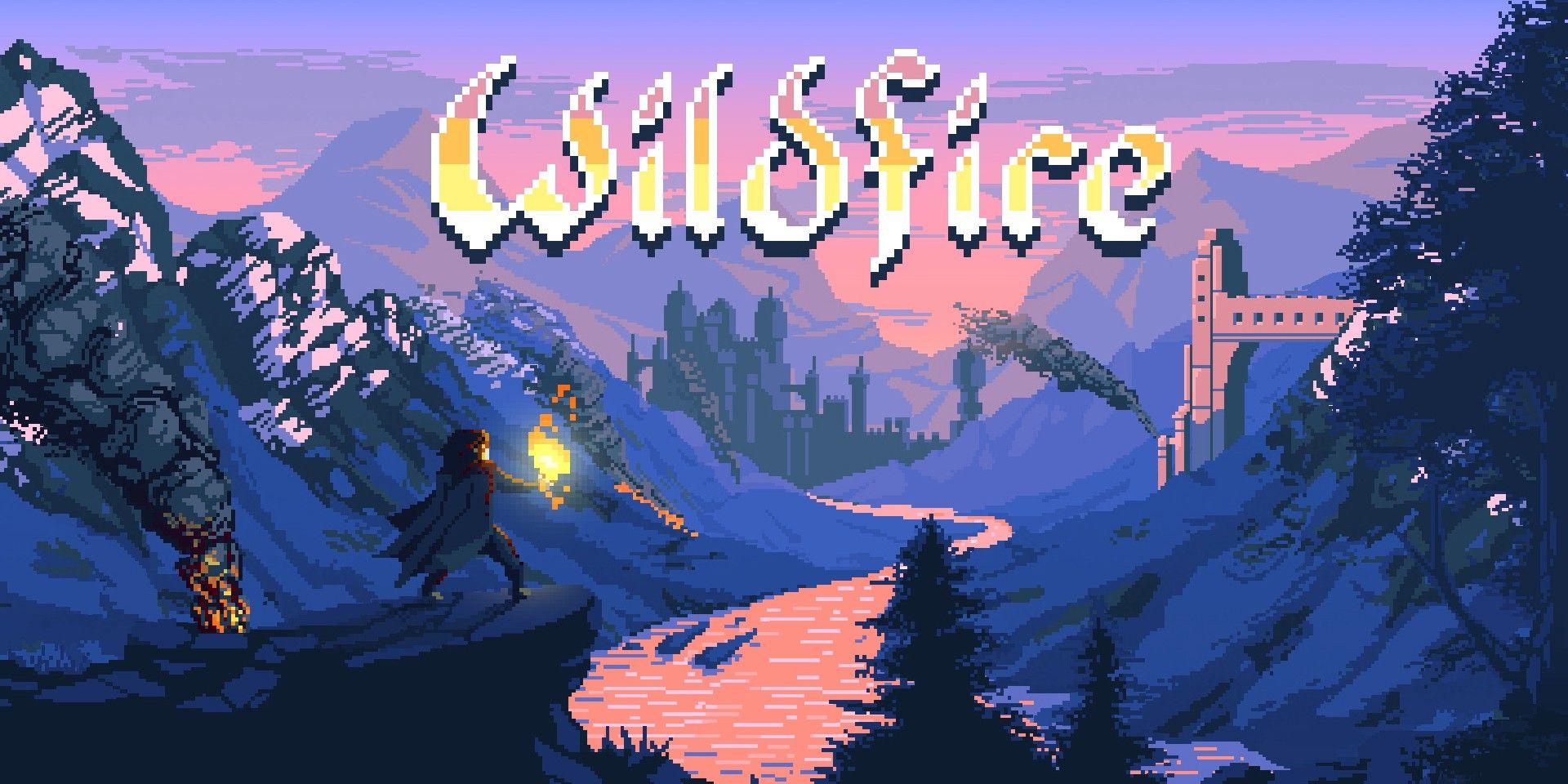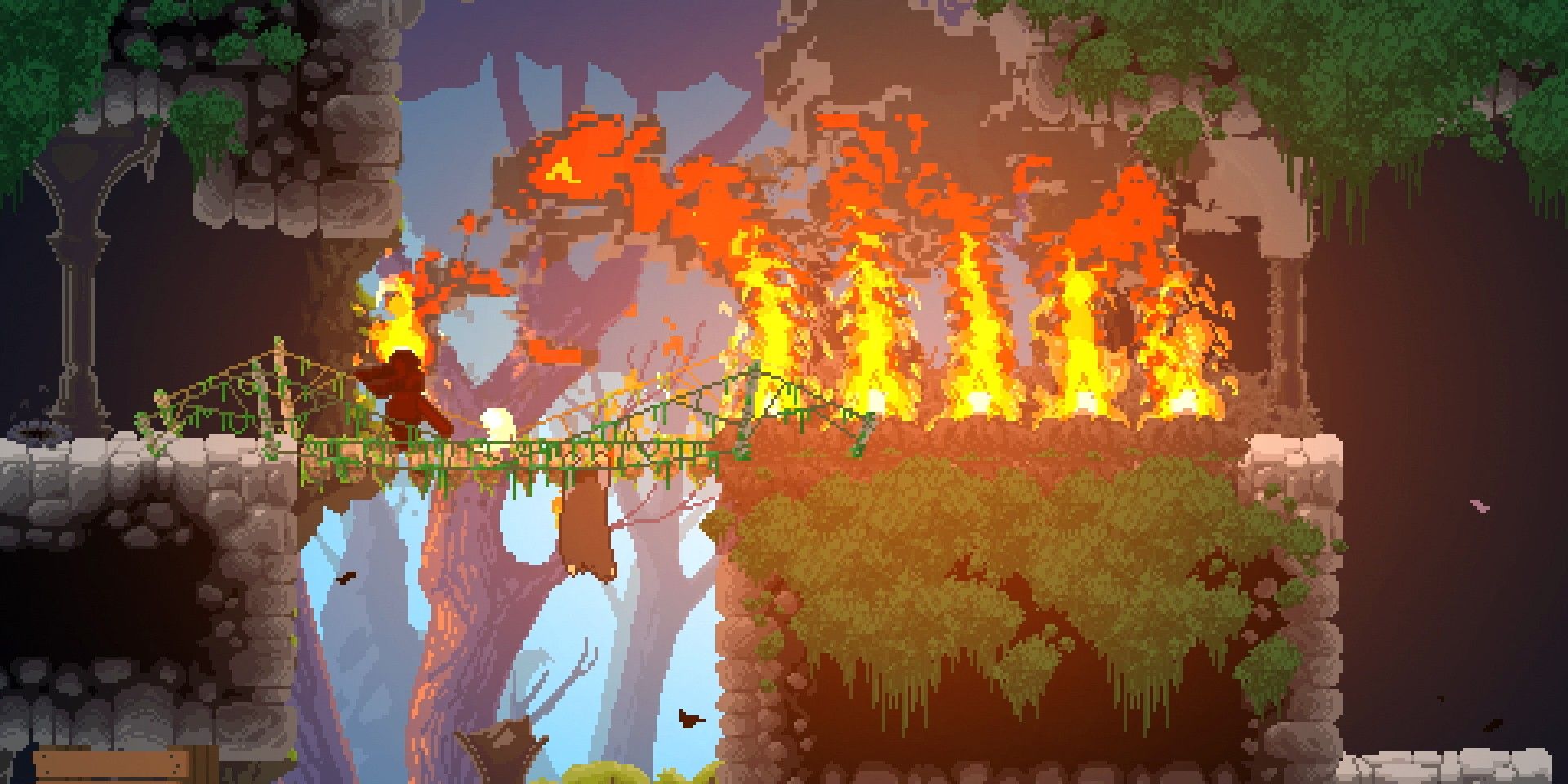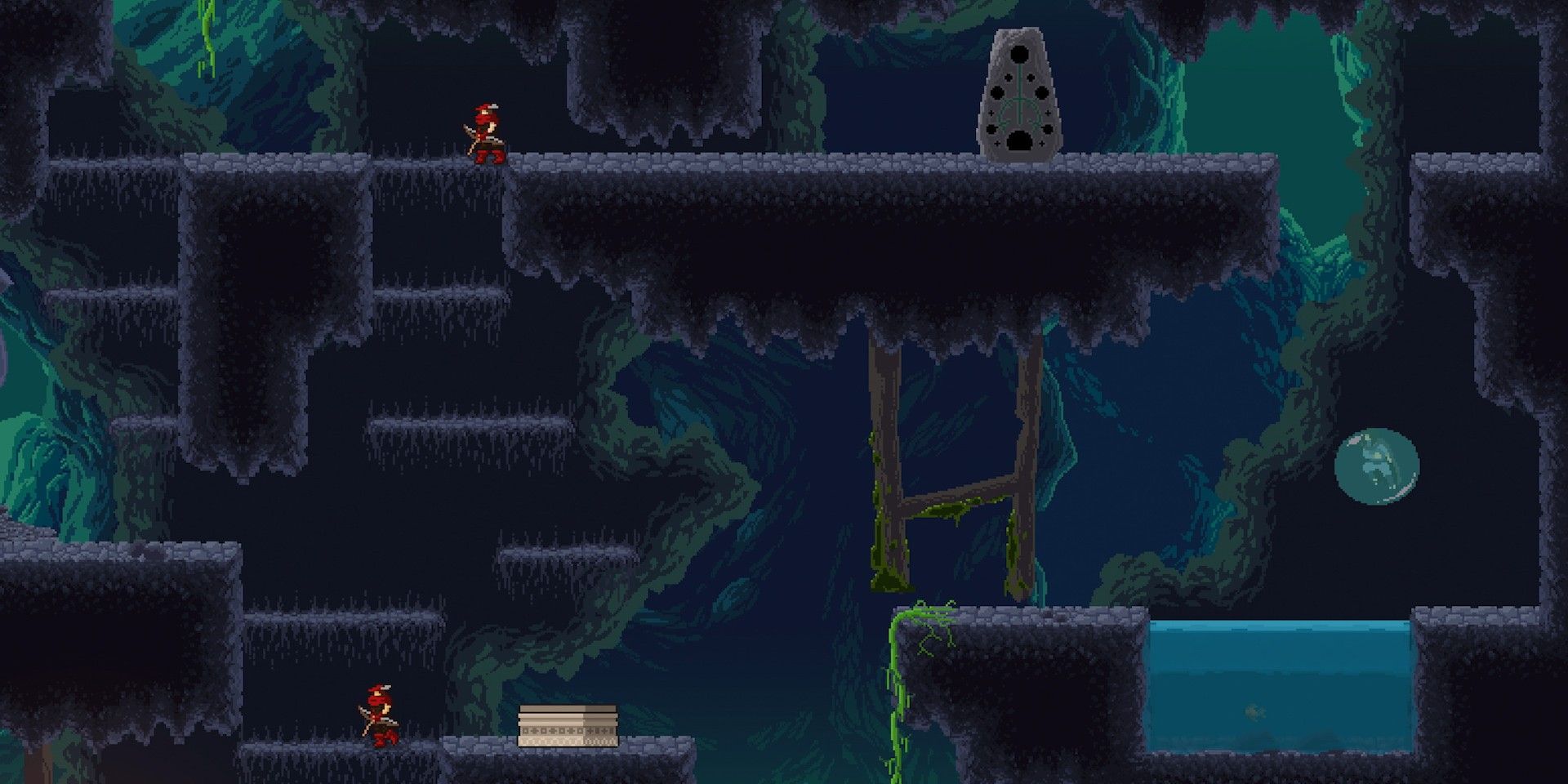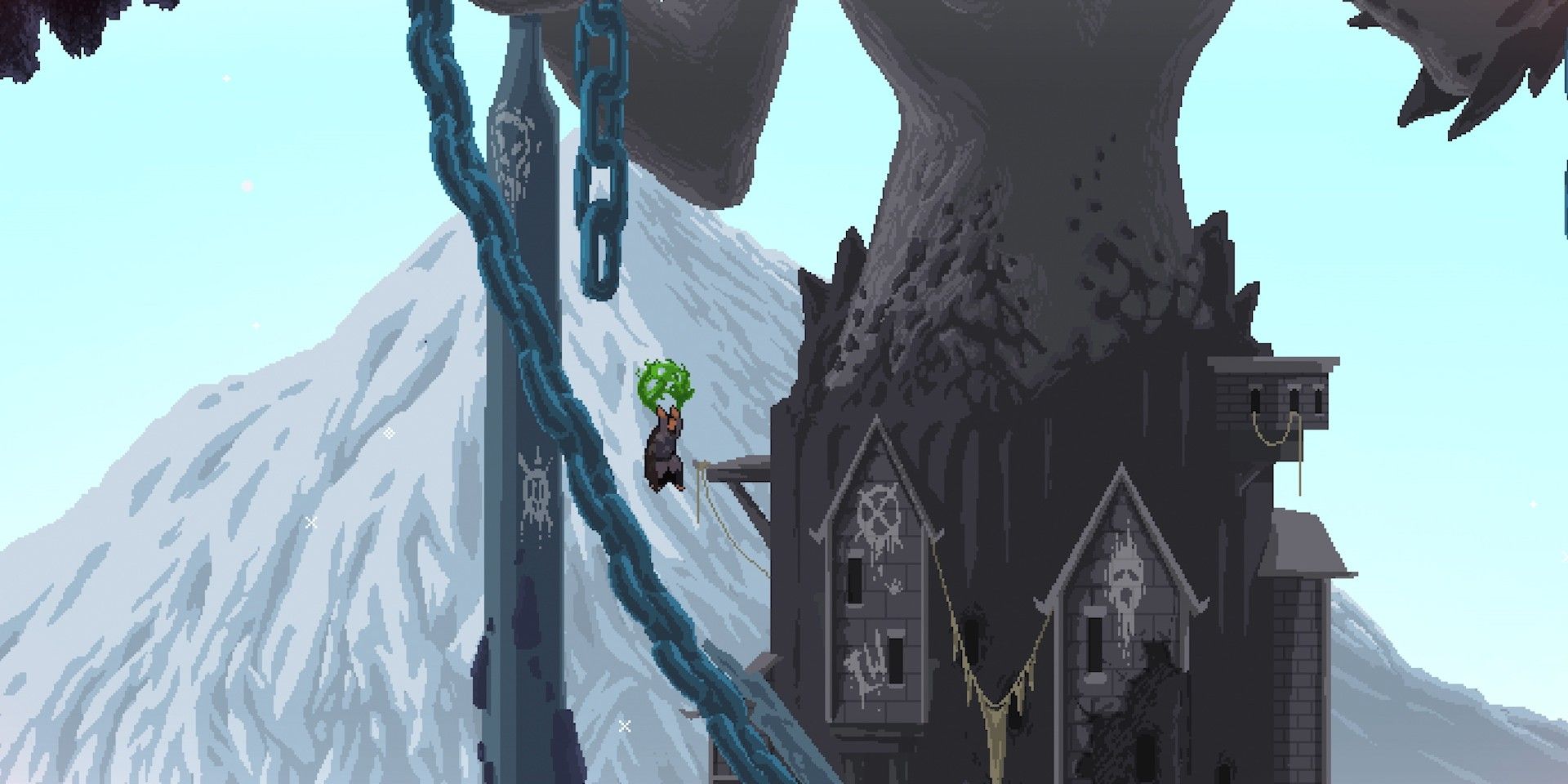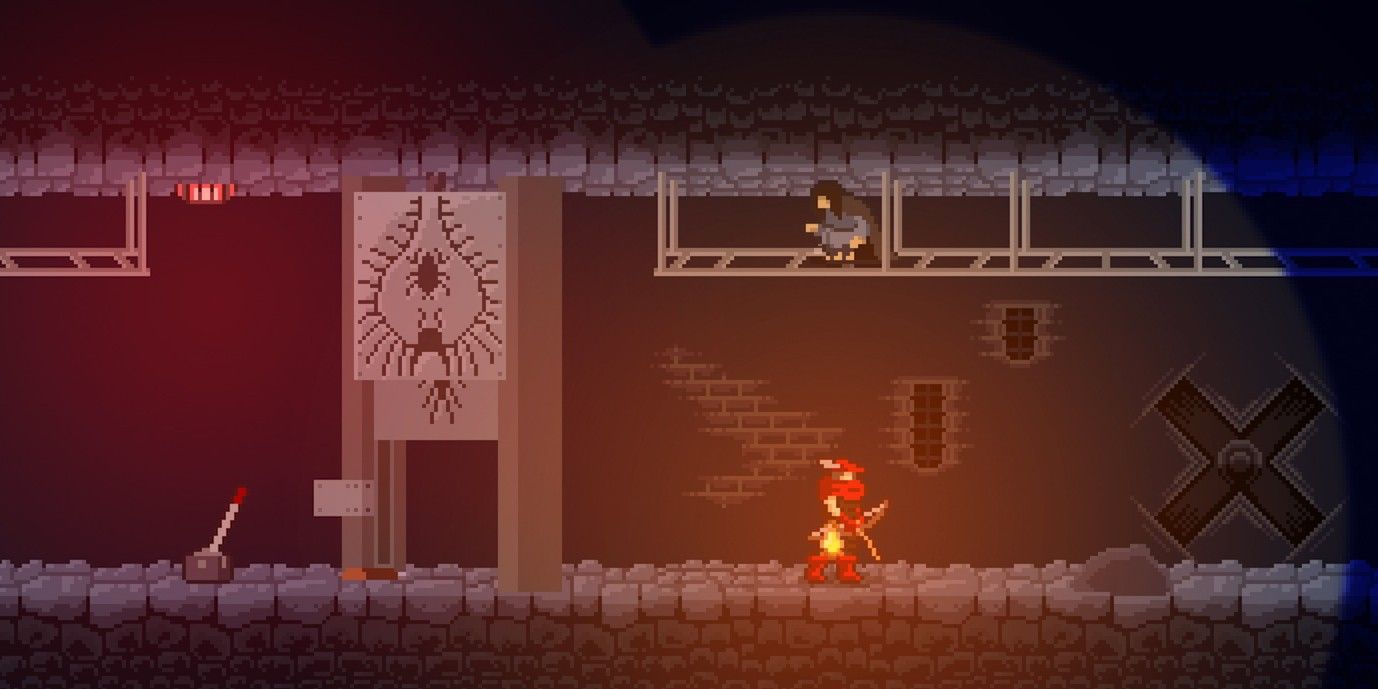Wildfire, available for the first time on consoles, dares to turn the high-stakes of stealth missions and timing puzzles into a beautiful coming-of-age journey for player and character alike. Intricate level design coupled with beautifully-crafted art and music make Wildfire a lovely game to play, but the process of learning the mechanics of elemental magic along with the character makes the game even more engrossing. Even when the scripted narrative falls flat, Wildfire still entrances with its gameplay.
In a world that has lost knowledge of magic, the player chases down a fallen meteor and gains access to elemental powers when they find it. Because of their control over fire, they are branded a witch by the evil forces of the Arch Duchess, who have also burned down the player's village. Players must rescue their fellow villagers from the clutches of the Arch Duchess' armies in order to rebuild their home.
Wildfire bills itself as a 2D stealth platformer, which is true without being descriptive. Navigating each level's maze of platforms to rescue villagers involves more than just jumping at the right time -- it requires players to embrace their elemental magic. Pathfinding becomes training in how to arc a smoke bomb or burn down just the right amount of grass. For a nascent witch only just connecting with the elements, each level is a satisfying puzzle to solve but also part of the character's growth.
Part of what creates the experience of coming-of-age with magical powers is the puzzle-like nature of each level. Getting to the exit is an exercise in finding the right path through environmental obstacles, requiring strategic use of powers both magical (like burning grass to frighten guards away) and mundane (like a good whistle to attract attention). Spending time path-planning but also attempting and failing to aim a fireball and restarting the level to get it right forces the player to mimic the process of training and studying, allowing them to grow into their character as their character grows into their powers.
But Wildfire's puzzles do more than provide the background against which character growth can occur. In each level, the player has to determine their own strategy to bypass enemies and environmental obstacles and choose which goals they find worth pursuing.
Meteor fragments, shrines and possible element upgrades are all available, but none of them have to be acquired in order to successfully complete an objective. Pop-up text tells them to burn down 90 percent of the vegetation or overhear an argument between guards, but none of these are necessary for a successful rescue. By providing more than one possible path to victory, Wildfire gives the player freedom to explore and to craft an intensely personal experience with each level.
Players also choose how they want to dispatch enemies, either scaring them off and hiding from them or attacking them. While many levels feature bonuses for no deaths, it's ultimately up to the player whether they want to fling a fireball at a guard. Putting the weight of the moral choice on the player gives the game a bit of an Undertale vibe, allowing them to craft their character's identity in a more personal way.
While the puzzle design offers lots of opportunities for individualizing play-throughs, it also sets the game apart as something more than just a platformer. Wildfire gives players the tools they need to sneak past guards, distract them or even fight them. As players wait, crouched in the tall grass to pick the pocket of guards as they walk past and then burn the ground behind them, it's hard not to be reminded of more cinematic mainstream hits like Assassin's Creed.
Another aspect of Wildfire that sets it apart from other platformers is its meticulously crafted environments. The game is about using the elements, and while each level needs to include basics like ponds, vines and flammable substances, the rest of the art reflects the environmental theme with lush backgrounds. The beauty of the environment may seem at odds with the 8-bit style graphics of the characters, but the combination ends up eliciting a sense of nostalgia for the graphics of the past and the beauty of the fictional landscapes.
Each individual level of Wildfire seems impeccably planned, but the larger narrative of the game that tries to link these levels together falls flat. Much of the plot isn't driven by the character (and therefore, the player), but rather happens in-between levels. Interstitial text informs the player of major events, like finding some of the captured villagers, and introduces villains like the Arch Duchess. The gameplay and environment are immersive, but the presentation of the larger narrative feels slapdash and can pull a player out of the otherwise meticulously curated experience.
There are moments where the design choices also seem as though they're cobbled together from different games. Each level includes a poem near its beginning that tells a moral story of someone using elemental magic in some way that has gone very wrong. While the poems themselves are compelling, they betray a sort of horror-esque foreshadowing that is at odds not only with the rest of the gameplay, but the general aesthetic.
Wildfire had previously been released on PC back in May, and many had enjoyed an alpha version years previously. Originally Kickstarted back in 2015, the game received massive support of more than twice its original goal. With playable builds of the game starting in 2016, Daniel Hindes and the rest of Sneaky Bastards spent the time necessary to introduce new mechanics, such as underhanging, but also to rigorously test the game to weed out bugs and publish a polished version.
The console version of the game brings the lush environments and the coming-of-age story to even more players. Now available on Nintendo Switch, PlayStation 4 and Xbox One, Wildfire may be the perfect cathartic game for surviving the cold, lonely winter by burning it to the ground. The console transition also introduces some mechanical difficulties, however. Aiming with the right joystick and firing with the right trigger proves a difficult combination, often resulting in misfiring fireballs and losing a flame that the player has fought to carry.
The sprites themselves are also frustratingly small. Devoting much of the screen real-estate to the environmental puzzles makes a lot of sense, but it leaves the characters relatively tiny, making navigating sometimes difficult. This is especially true on smaller screens, like the Switch Lite, but is even true of larger displays. Identifying the edge of platforms, especially at a run, becomes tricky at this size.
Wildfire invites players into a beautiful world with the promise of using stealth and fighting techniques as a puzzle-solving measure, and the game definitely delivers. The art design and music of each level work to draw the player further in. If the narrative binding each level fails to cohere, it certainly doesn't detract from rush of successfully rescuing a villager or figuring out a sequence of bubbles and smoke bombs that allow the player to complete a level.
Developed by Sneaky Bastards and published by Humble Games, Wildfire is available on PC, Nintendo Switch, PlayStation 4 and Xbox One. A review copy was provided by the publisher.

